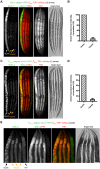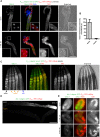The auxin-inducible degradation (AID) system enables versatile conditional protein depletion in C. elegans
- PMID: 26552885
- PMCID: PMC4689222
- DOI: 10.1242/dev.129635
The auxin-inducible degradation (AID) system enables versatile conditional protein depletion in C. elegans
Abstract
Experimental manipulation of protein abundance in living cells or organisms is an essential strategy for investigation of biological regulatory mechanisms. Whereas powerful techniques for protein expression have been developed in Caenorhabditis elegans, existing tools for conditional disruption of protein function are far more limited. To address this, we have adapted the auxin-inducible degradation (AID) system discovered in plants to enable conditional protein depletion in C. elegans. We report that expression of a modified Arabidopsis TIR1 F-box protein mediates robust auxin-dependent depletion of degron-tagged targets. We document the effectiveness of this system for depletion of nuclear and cytoplasmic proteins in diverse somatic and germline tissues throughout development. Target proteins were depleted in as little as 20-30 min, and their expression could be re-established upon auxin removal. We have engineered strains expressing TIR1 under the control of various promoter and 3' UTR sequences to drive tissue-specific or temporally regulated expression. The degron tag can be efficiently introduced by CRISPR/Cas9-based genome editing. We have harnessed this system to explore the roles of dynamically expressed nuclear hormone receptors in molting, and to analyze meiosis-specific roles for proteins required for germ line proliferation. Together, our results demonstrate that the AID system provides a powerful new tool for spatiotemporal regulation and analysis of protein function in a metazoan model organism.
Keywords: Auxin; Auxin-inducible degradation; C. elegans; Degron; Genetic tool; Tissue-specific depletion.
© 2015. Published by The Company of Biologists Ltd.
Conflict of interest statement
The authors declare no competing or financial interests.
Figures





Similar articles
-
An expanded auxin-inducible degron toolkit for Caenorhabditis elegans.Genetics. 2021 Mar 31;217(3):iyab006. doi: 10.1093/genetics/iyab006. Genetics. 2021. PMID: 33677541 Free PMC article.
-
The mIAA7 degron improves auxin-mediated degradation in Caenorhabditiselegans.G3 (Bethesda). 2022 Sep 30;12(10):jkac222. doi: 10.1093/g3journal/jkac222. G3 (Bethesda). 2022. PMID: 36029236 Free PMC article.
-
Rapid Degradation of Caenorhabditis elegans Proteins at Single-Cell Resolution with a Synthetic Auxin.G3 (Bethesda). 2020 Jan 7;10(1):267-280. doi: 10.1534/g3.119.400781. G3 (Bethesda). 2020. PMID: 31727633 Free PMC article.
-
Auxin-inducible degron system: an efficient protein degradation tool to study protein function.Biotechniques. 2023 Apr;74(4):186-198. doi: 10.2144/btn-2022-0108. Epub 2023 May 16. Biotechniques. 2023. PMID: 37191015 Review.
-
Rapid Depletion of Budding Yeast Proteins via the Fusion of an Auxin-Inducible Degron (AID).Curr Protoc Cell Biol. 2014 Sep 2;64:20.9.1-16. doi: 10.1002/0471143030.cb2009s64. Curr Protoc Cell Biol. 2014. PMID: 25181302 Review.
Cited by
-
A genetic screen for temperature-sensitive morphogenesis-defective Caenorhabditis elegans mutants.G3 (Bethesda). 2021 Apr 15;11(4):jkab026. doi: 10.1093/g3journal/jkab026. G3 (Bethesda). 2021. PMID: 33713117 Free PMC article.
-
The C. elegans gonadal sheath Sh1 cells extend asymmetrically over a differentiating germ cell population in the proliferative zone.Elife. 2022 Sep 12;11:e75497. doi: 10.7554/eLife.75497. Elife. 2022. PMID: 36094368 Free PMC article.
-
A dual molecular analogue tuner for dissecting protein function in mammalian cells.Nat Commun. 2016 May 27;7:11742. doi: 10.1038/ncomms11742. Nat Commun. 2016. PMID: 27230261 Free PMC article.
-
Temporal Analysis of DSB Repair Outcome in Caenorhabditis elegans Meiosis.Methods Mol Biol. 2024;2818:195-212. doi: 10.1007/978-1-0716-3906-1_13. Methods Mol Biol. 2024. PMID: 39126476
-
Feeding state functionally reconfigures a sensory circuit to drive thermosensory behavioral plasticity.Elife. 2020 Oct 19;9:e61167. doi: 10.7554/eLife.61167. Elife. 2020. PMID: 33074105 Free PMC article.
References
Publication types
MeSH terms
Substances
Grants and funding
LinkOut - more resources
Full Text Sources
Other Literature Sources
Molecular Biology Databases
Research Materials

